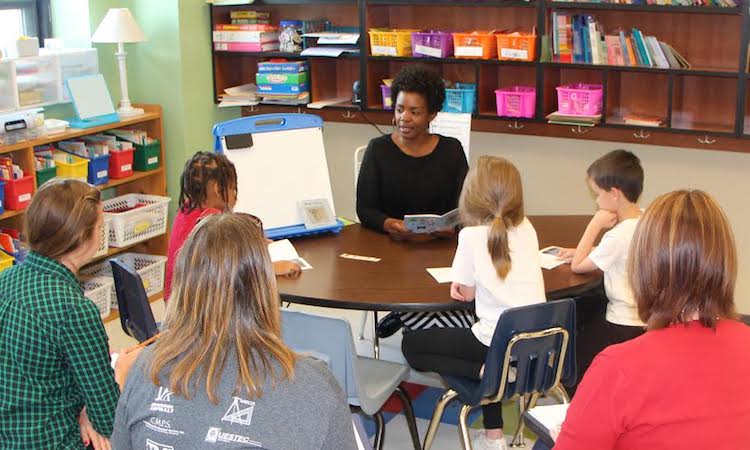By Paula Dugger, M. Ed., Guest Blogger
Children come from different backgrounds and experiences, and as a result, they arrive in schools with distinct abilities in literacy. Some children require extra help in learning to read and write. In this blog post, I'll share how you can implement targeted interventions that will help your students improve reading and writing. First I'll reference some insightful content from a professional resource, and then I'll describe how you can put the insights into practice with narrative and informational texts.
My daughter and I recently took my granddaughter to see the pediatrician for an illness. The doctor asked a series of questions about her symptoms, took her temperature, looked at her throat, and checked her vitals. After assessing the illness, the doctor prescribed a treatment plan, including medication, and scheduled another appointment to recheck her condition.
In much the same way, we assess the reading proficiency of our students by making observations while listening to their reading, and asking questions to determine their comprehension. If a problem is discovered, we have to prescribe a plan that will include leveled books and reading comprehension activities to rectify the issue. Hopefully the issue will be resolved within a short period of time, but if not, we have to create a new plan.
Targeted intervention is a term used to describe a formalized set of steps that incorporate instructional practices designed to help a child with specific areas of need. Research indicates that children who are at risk for failing in reading can often be helped if the intervention is early and if the reading instruction is explicit and intensive. This means early intervention can help struggling readers make gains in a short amount of time, which hopefully closes their literacy gap by third grade.
 What does a targeted intervention for literacy look like in a school setting? In Chapter 3 of
Changing Minds, Changing Schools, Changing Systems: A Comprehensive Literacy Design for School Improvement
, the Comprehension Intervention Model (CIM) is presented. CIM is designed to assist teachers in matching student needs to an intervention. The interventions found in the CIM, including Targeted Intervention, are “structured around predictable lesson components and established routines with daily instruction.” The predictable lesson components include:
What does a targeted intervention for literacy look like in a school setting? In Chapter 3 of
Changing Minds, Changing Schools, Changing Systems: A Comprehensive Literacy Design for School Improvement
, the Comprehension Intervention Model (CIM) is presented. CIM is designed to assist teachers in matching student needs to an intervention. The interventions found in the CIM, including Targeted Intervention, are “structured around predictable lesson components and established routines with daily instruction.” The predictable lesson components include:
- Vocabulary Development
- Phonological Awareness
- Word Study
- Comprehension Strategies
- Writing Process
- Language Development
With explicit and targeted instruction during guided reading and writing activities, a child can rapidly build a large foundation of vocabulary words and skills. An expert teacher can use reciprocity between reading and writing to teach word-solving strategies that will increase both reading and writing vocabulary. A reader should be able to read what they write, as well as write what they read, because one learns about words with every reading and writing experience.
 In
Changing Minds, Changing Schools, Changing Systems
, there is a scenario about a first-grader named Angela who scored slightly below grade level in reading. Her teacher determined that in addition to her regular classroom instruction, she needed to incorporate more days and minutes of reading and writing practice for Angela within a small-group setting. The teacher was able to make informed instructional decisions using books at Angela's independent level, as well as a text reading measure conducted every two weeks to monitor progress. If there was a lack of progress, further diagnostic assessments needed to be provided with the help of a CIM Specialist.
In
Changing Minds, Changing Schools, Changing Systems
, there is a scenario about a first-grader named Angela who scored slightly below grade level in reading. Her teacher determined that in addition to her regular classroom instruction, she needed to incorporate more days and minutes of reading and writing practice for Angela within a small-group setting. The teacher was able to make informed instructional decisions using books at Angela's independent level, as well as a text reading measure conducted every two weeks to monitor progress. If there was a lack of progress, further diagnostic assessments needed to be provided with the help of a CIM Specialist.
Just like Angela, my Reading Recovery students’ lessons contained targeted skills unique to each child. Using the Observation Survey (a series of six literacy subtests), I created an intervention plan for each student that included a daily running record using leveled readers for progress monitoring. Sharing information and collaborating with the classroom teachers allowed each of my students to receive daily structured and predictable lessons geared to create independent readers and writers.
At the beginning of the blog, I compared an intervention to a doctor’s visit because there are similarities between a sick patient and a student who struggles with reading. Both need diagnoses to determine the problem and a treatment, or instructional plan, designed to correct the problem(s). It is important that the patient or student’s problem be frequently monitored until intervention is no longer needed.
In addition to the core reading program that Angela’s teacher used, Angela received small-group instruction in a few targeted areas: writing about reading, word study, and vocabulary development. With explicit and targeted instruction, along with additional teaching minutes in these areas, the goal was to accelerate progress to reach the desired outcome.
 One of the narrative texts I've used with my Reading Recovery students to help introduce a word-solving strategy was
Wishy-Washy Ice Cream
(level C) from
Joy Cowley Early Birds
. While the text is patterned to help support a beginning reader, the pattern also has changes that requires word-solving skills. You can click on the image of the downloadable lesson plan at the end of this blog post to use with leveled reader
Wishy-Washy Ice Cream
.
One of the narrative texts I've used with my Reading Recovery students to help introduce a word-solving strategy was
Wishy-Washy Ice Cream
(level C) from
Joy Cowley Early Birds
. While the text is patterned to help support a beginning reader, the pattern also has changes that requires word-solving skills. You can click on the image of the downloadable lesson plan at the end of this blog post to use with leveled reader
Wishy-Washy Ice Cream
.
I've also used The New Road (level E) from the Junior Set within the Joy Cowley Early Birds . I use this text for a writing lesson that links to reading by activating prior knowledge and making real world connections to the repetitive phrase went the , which is found through the book. I encourage the student think of familiar sounds from animals or in the environment by asking questions like What sound does a cow (or dog, or thunder, or horn) make? This helps the child respond with a sentence that incorporates the repeated phrase: Moo went the cow. Honk, honk went the horn.
 By generating several sentences with this simple sentence structure,
went
and
the
should soon become recognizable sight words in reading and easy words to write. For word study and vocabulary instruction with
The New Road
, you can use the downloadable word-solving lesson but you can focus on the word chunk
-ent
in
went
. Kids will easily be able to use the same strategy to make the words by adding different letters to
-ent
, such as
bent
,
cent
,
dent
,
rent
, and
sent
.
By generating several sentences with this simple sentence structure,
went
and
the
should soon become recognizable sight words in reading and easy words to write. For word study and vocabulary instruction with
The New Road
, you can use the downloadable word-solving lesson but you can focus on the word chunk
-ent
in
went
. Kids will easily be able to use the same strategy to make the words by adding different letters to
-ent
, such as
bent
,
cent
,
dent
,
rent
, and
sent
.
In addition to narrative texts, you should use nonfiction books for kids as a part of your reading and writing intervention. The Sun is a great level G informational book from Fables & the Real World because it allows kids to tap into background knowledge about something they see every day. This book is also a powerful tool to help kids read and write across content areas.
The text also contains a number of compound words, which can be broken apart easily for word study. Cannot , daytime , sunglasses , without , someday , today , and because are prime words for teaching word-solving strategies with compound words. The help you provide will make it easier for children to decode these multi-syllable words.
 Using magnetic letters, I model how to look for known parts or words within a word. For instance, I would take the word “cannot “and pull “can” away from “not” to show that it is much easier to decode this word by looking at two parts or chunks I know, rather than trying to decode the word letter-by-letter. Allowing the student to repeat this activity with a variety of words from the story and then attempting to write them by saying the words in chunks, reinforces both reading and writing vocabulary.
Using magnetic letters, I model how to look for known parts or words within a word. For instance, I would take the word “cannot “and pull “can” away from “not” to show that it is much easier to decode this word by looking at two parts or chunks I know, rather than trying to decode the word letter-by-letter. Allowing the student to repeat this activity with a variety of words from the story and then attempting to write them by saying the words in chunks, reinforces both reading and writing vocabulary.
An intervention supplements the regular classroom instruction for those students who need additional help and support in a targeted area. Providing a flexible intervention with literacy strategies that target an identified area of need can help accelerate progress and eliminate the problem.
My granddaughter regained her health through a successful diagnosis and strategic intervention. Eliminating a child’s literacy problems can also be resolved when an intervention plan monitors and provides a targeted intervention. An early, strategic literacy plan can take a student from being a struggling reader to a striving reader.
I invite you to revisit this blog soon for more lesson ideas and teaching tips. Don't forget to click on the downloadable lesson plan below to use with Wishy-Washy Ice Cream .
 Paula is an educational consultant who has previously served as a Reading Recovery Teacher/Teacher Leader, first grade teacher, Title I and high school reading teacher, and a Reading Coordinator. If you like what you read here, you can enjoy
more from Paula on our blog
.
Paula is an educational consultant who has previously served as a Reading Recovery Teacher/Teacher Leader, first grade teacher, Title I and high school reading teacher, and a Reading Coordinator. If you like what you read here, you can enjoy
more from Paula on our blog
.







